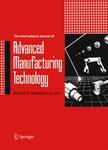版权所有:内蒙古大学图书馆 技术提供:维普资讯• 智图
内蒙古自治区呼和浩特市赛罕区大学西街235号 邮编: 010021

作者机构:Changan Univ Sch Construct Machinery Inst Smart Mfg Syst Xian Peoples R China Shandong Univ Sci & Technol Qingdao 266590 Peoples R China Changan Univ Sch Elect & Control Engn Xian 710064 Peoples R China Hong Kong Polytech Univ Dept Ind & Syst Engn Hong Kong Peoples R China
出 版 物:《INTERNATIONAL JOURNAL OF ADVANCED MANUFACTURING TECHNOLOGY》 (国际先进制造技术杂志)
年 卷 期:2021年第116卷第1-2期
页 面:213-227页
核心收录:
学科分类:12[管理学] 1201[管理学-管理科学与工程(可授管理学、工学学位)] 08[工学] 0802[工学-机械工程] 0811[工学-控制科学与工程]
基 金:National Natural Science Foundation of China Fundamental Research Funds for the Central Universities, CHD [300102250303, 300102250201] Natural Science Basic Research Program of Shaanxi [2020JQ-380, 2021JM-166] Major Special Science and Technology Project of Shaanxi Province, China [2018zdzx01-01-01]
主 题:Cutting power Milling process Cutting force Energy consumption Taguchi orthogonal design
摘 要:Accurately characterizing the energy consumption of machining processes is a starting point to increase manufacturing energy efficiency and reduce their associated environmental impacts. As a significant contributor of machining power consumption, the material removal power can be predicted by three different approaches: multiplying specific cutting energy by material removal rate (approach I), multiplying cutting forces by the cutting speed (approach II), and modeling the power consumption as exponential functions of cutting parameters (approach III). However, there is no general agreement about the accuracy of different modeling approaches. Therefore, this paper aims to test and compare different modeling approaches with respect to their suitability to predict the material removal power in the milling process. In order to obtain the coefficients in the models, experiments were carried out on a machine center. Three types of workpiece materials (carbon steel, aluminum, and ductile iron) are selected for cutting tests. Four-factor (cutting speed, feed, depth of cut, and width of cut) four-level orthogonal experiments are employed based on Taguchi s method. Dynamometer and power acquisition devices were used to measure the cutting force and machine power. Then a set of models were established using coefficients obtained from literatures or regression analysis of experimental data. Values of material removal power predicted by the three approaches are compared with those from confirmation experiments. When using coefficients from literatures, the prediction accuracy varies from 51.2 to 87.7% for steel, 49.3 to 64.6% for aluminum, and 57.2 to 90.9% for ductile iron, depending on the sources of coefficients. When the coefficients are obtained experimentally, the prediction accuracy of all approaches is over 83.9%. In this case, approach III achieves the highest prediction accuracy, followed by approach II and approach I for steel. Approaches I and III give the highest p